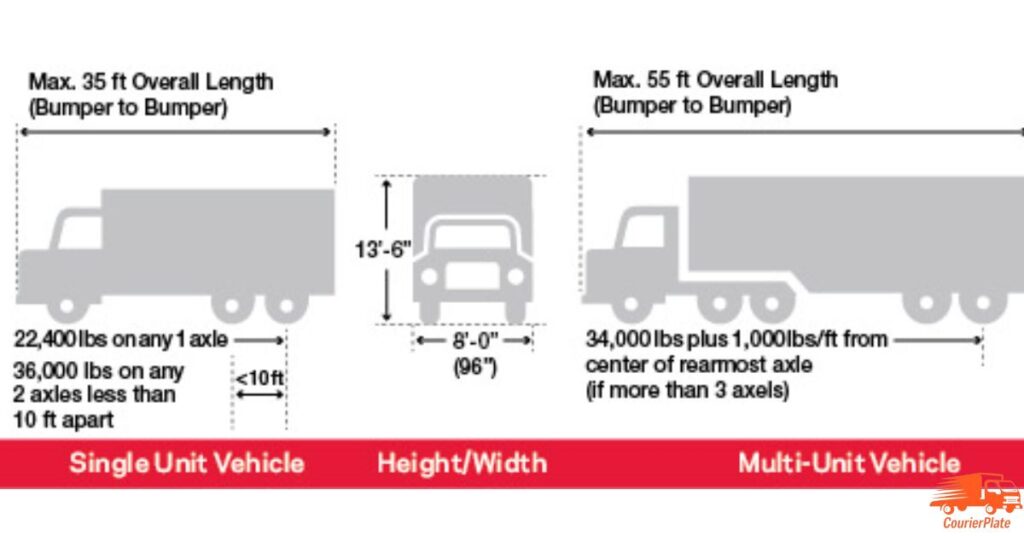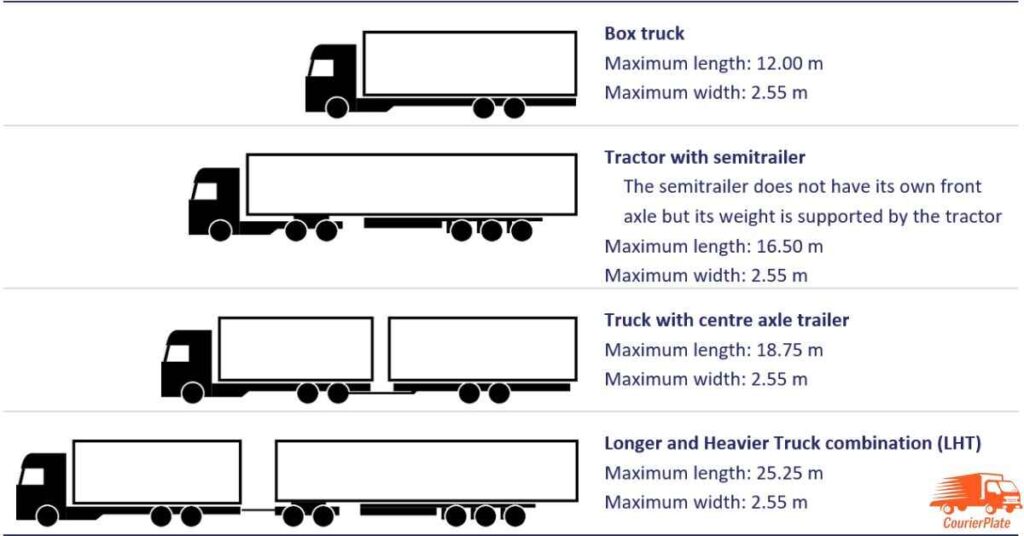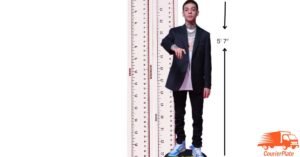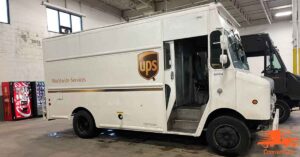A UPS delivery truck’s height directly impacts efficient package delivery, infrastructure clearance, and driver safety. Choosing the wrong vehicle height can lead to accidents, damaged infrastructure, or delivery delays. Many logistics managers and fleet operators struggle with these limitations, causing operational inefficiencies and increased costs.
UPS has optimized their delivery truck heights through decades of experience. Their standard delivery trucks stand at 9’6″ to 12′ tall, depending on the model, carefully designed to balance cargo capacity with safe navigation. This comprehensive guide examines UPS truck dimensions, specifications, and design factors to help logistics professionals understand height requirements for different delivery scenarios.
Standard UPS Truck Dimensions
UPS operates a diverse fleet of delivery vehicles. Each vehicle is carefully designed to meet specific delivery needs. The dimensions of these trucks are crucial for safe and efficient operations.
Height Specifications Across the Fleet
UPS delivery trucks come in various heights to serve different purposes. The standard package car stands 9’6″ tall. This height allows for easy access to most urban areas. Larger models reach up to 12 feet in height. These taller vehicles are used for routes with fewer overhead restrictions.
Industry standards typically range from 9′ to 13.5′ for commercial delivery vehicles. UPS maintains its fleet within these limits. The company regularly updates its specifications to match changing delivery needs.
UPS Truck Height Specifications (As of 2024)
| Vehicle Type | Standard Height | Maximum Height |
| Package Car | 9’6″ | 10′ |
| P1000 | 11′ | 11’6″ |
| Semi-Truck | 13′ | 13’6″ |
| City Delivery Van | 8’6″ | 9′ |
Width and Length Measurements

UPS trucks measure 8 feet in width. This width provides stability while meeting road regulations. The length varies from 20 to 30 feet for standard delivery trucks. Longer vehicles serve routes with higher package volumes.
The width-to-height ratio ensures balance during transport. Wider trucks can safely carry more weight at greater heights. A typical UPS truck has 630 cubic feet of cargo space. This space accommodates various package sizes and shapes.
Weight Capacity and Load Limits
UPS trucks can carry between 10,000 to 12,000 pounds of cargo. This weight limit depends on the vehicle model and local regulations. Heavier loads require specific height and width configurations for safe transport.
Each axle has its own weight restriction. Front axles typically handle 4,000 pounds. Rear axles support up to 8,000 pounds. These limits protect roads and ensure vehicle safety.
UPS Truck Weight Limits (2024 Standards)
| Vehicle Type | Maximum Load | GVWR* |
| Package Car | 10,000 lbs | 14,500 |
| P1000 | 12,000 lbs | 16,500 |
| Semi-Truck | 80,000 lbs | 80,000 |
| City Delivery Van | 5,000 lbs | 9,000 |
*GVWR: Gross Vehicle Weight Rating
These dimensions and limits ensure safe, efficient deliveries. They help UPS maintain its reputation for reliable service. The company updates these specifications as delivery needs evolve.
Types of UPS Delivery Vehicles and Their Heights
UPS maintains a diverse fleet of vehicles to handle different delivery needs. Each vehicle type serves specific purposes in the delivery network.

Package Cars (Standard Delivery Trucks)
The brown package car is UPS’s most common delivery vehicle. It stands 9’6″ tall with distinctive sliding doors. These trucks feature shelves and bins for organized package storage. Package cars operate in residential and commercial areas. They complete most local deliveries.
Package Car Specifications (2024)
| Feature | Measurement |
| Height | 9’6″ |
| Door Clearance | 8′ |
| Shelf Height | 7’6″ |
| Storage Space | 630 cu. ft. |
Semi-Trucks and Trailers
UPS semi-trucks reach heights of 13’6″. These larger vehicles transport packages between distribution centers. They connect seamlessly with standard loading docks at 48-52 inches high. Semi-trucks travel long distances on major highways.
Urban Delivery Vehicles
Urban vehicles stand shorter at 8’6″. This lower height helps them navigate city obstacles. They feature tight turning radiuses for narrow streets. Special design elements include backup cameras and side sensors.
Electric and Alternative Fuel Vehicles
Electric delivery vehicles maintain similar heights to standard trucks. They include battery packs in the chassis without extra height. UPS plans to add 10,000 electric vehicles by 2025. These vehicles help reduce emissions in urban areas.
UPS Electric Fleet Growth
| Year | Electric Vehicles |
| 2020 | 2,500 |
| 2022 | 5,000 |
| 2024 | 7,500 |
| 2025 | 10,000 |
Safety and Regulatory Considerations
Safe operation requires strict attention to vehicle height limits and clearances. UPS maintains high safety standards across its fleet.
Height Clearance Requirements
Minimum clearance adds 3 inches to vehicle height. Bridges must provide at least 13’9″ clearance for semi-trucks. Urban routes require 10′ minimum clearance for package cars. UPS maps all routes for proper clearance.
Legal Height Restrictions
Federal law limits commercial vehicle height to 13’6″. States may allow heights up to 14′ on specific routes. International standards vary by country. UPS complies with all local regulations.
Height Restrictions by Region (2024)
| Region | Maximum Height |
| US Federal | 13’6″ |
| Canada | 4.15m (13’7″) |
| European Union | 4m (13’1″) |
| Mexico | 4.25m (13’11”) |
Safety Features and Systems
Modern UPS trucks include height monitoring systems. These alert drivers to low clearances ahead. Additional features include:
- Clearance sensors
- GPS-based route planning
- Automatic emergency braking
UPS updates safety systems annually. They track bridge heights in real-time. Driver training emphasizes height awareness. These measures prevent accidents and protect infrastructure.
Design and Engineering Factors
Modern UPS trucks blend efficiency with practical design. The engineering focuses on both performance and functionality.
Aerodynamic Considerations
UPS trucks use curved roof designs to reduce air resistance. The front angles slope gently to cut through wind. This shape saves 10% on fuel costs. Tests show that higher trucks face more wind resistance. The ideal height balances cargo space with fuel efficiency.
Aerodynamic Design Impact (2024 Data)
| Design Feature | Fuel Savings |
| Curved Roof | 3-5% |
| Front Slope | 2-3% |
| Side Panels | 2-4% |
| Total Improvement | 7-12% |
Cargo Space Optimization
The interior height of 7’6″ maximizes package storage. Shelves line both sides of the cargo area. The roof design creates 630 cubic feet of space. Each shelf section holds specific package sizes. The layout lets drivers access packages quickly.
Interior Space Configuration
| Area | Height | Capacity |
| Top Shelf | 24 inches | 150 lbs |
| Middle Shelf | 30 inches | 200 lbs |
| Bottom Shelf | 36 inches | 250 lbs |
| Floor Space | 48 inches | 400 lbs |
Loading Dock Compatibility
UPS trucks align with standard loading dock heights of 48-52 inches. The rear floor height adjusts for different docks. Special hydraulic systems help match dock levels. This design speeds up loading and unloading times.
Loading Dock Standards (2024)
| Dock Type | Height Range | Time to Dock |
| Standard Dock | 48-52 inches | 1-2 minutes |
| Low Dock | 44-47 inches | 2-3 minutes |
| High Dock | 53-56 inches | 2-3 minutes |
| Ground Level | 0-43 inches | 3-5 minutes |
The truck design includes a flat floor for easy movement. Wide rear doors open fully for dock access. These features help UPS handle over 24 million packages daily. Every design element serves a specific purpose in the delivery process.
Read This Blog: Gary Puckett Net Worth: A Deep Dive into the 1960s Pop Rock Sensation
Fleet Management and Maintenance

UPS takes its fleet management and maintenance very seriously, aiming to keep each delivery vehicle in top shape for reliable performance. Imagine an operation where each truck, van, or semi-truck undergoes precise maintenance to meet strict standards.
With over 119,000 vehicles in the fleet, UPS has a careful approach to managing vehicle upkeep and checks. Each truck is regularly checked to ensure it meets required safety protocols and continues to run smoothly. This attention to maintenance helps each UPS vehicle provide consistent, safe, and efficient delivery services.
Height-Related Maintenance
Height is a key focus in UPS’s fleet maintenance strategy. Regular inspections are scheduled for every vehicle, ensuring that each truck’s height remains compliant with road and bridge clearance standards. Trucks are examined for any wear and tear that could affect height, and this includes clearance checks to avoid any issues on the road.
Safety protocols ensure that drivers are aware of clearance limits and are trained to navigate safely through various routes. These protocols keep both the vehicle and its cargo secure, allowing UPS trucks to operate smoothly in urban and rural settings alike.
| Maintenance Aspect | Description | Frequency | Yearly Check Requirements |
| Inspection | Regular, thorough checkups | Quarterly | 4 per year |
| Clearance Check | Ensures height compliance | Biannually | 2 per year |
| Safety Protocols | Driver and vehicle safety | Ongoing | Continuous |
Fleet Standardization
UPS understands that height consistency across its fleet is critical to ensure each vehicle can meet standard delivery needs. By standardizing the height of its trucks and vans, UPS achieves greater operational efficiency across different regions. Fleet height can vary slightly depending on regional needs, but consistency is key.
This strategy enables UPS to make use of each truck’s capacity, aligning the entire fleet to UPS’s service demands while providing flexibility in both urban and rural environments. UPS’s fleet diversity also supports its drivers in adjusting to various delivery requirements.
| Fleet Standardization Aspect | Detail | Operational Impact | Regions Impacted |
| Height Consistency | Similar height standards across fleet | Improved efficiency | Nationwide |
| Regional Variations | Minor adjustments for specific areas | Better local navigation | Urban and rural areas |
| Operational Efficiency | Streamlined processes and clearances | Reduced delays | High-traffic areas |
Also Read: Terry Kiser’s Net Worth and Financial Success: Uncovering the Wealth of a Hollywood Icon
Future Trends and Innovations
The future of UPS trucks includes exciting innovations in height optimization and technology.
Emerging Technologies
With new technology, UPS is reimagining its delivery vehicles, exploring new designs and alternative vehicle types. This innovation is driven by a desire to improve height optimization, allowing trucks to navigate through low-clearance areas more easily.
Some new vehicle concepts have lower or flexible roofs, making them adaptable to different environments. Height optimization will allow UPS to better access areas with tight clearances, enhancing the efficiency of each delivery. Alternative vehicles like electric trucks and hybrid vans may also become more common in the fleet, bringing further flexibility.
| Technology Aspect | Description | Current Usage | Future Potential |
| Height Optimization | Designs for low-clearance accessibility | Limited | Expanded in urban areas |
| Electric Vehicles | Reduces emissions, quieter operations | Pilot programs | Full fleet adaptation |
| Alternative Vehicle Types | Flexible designs, smaller models | In testing | Nationwide rollout |
Sustainability Considerations
UPS is also paying close attention to the environmental impact of its fleet and vehicle heights. By reducing the height of some electric vehicles, UPS not only makes them better suited for congested areas but also contributes to lower energy consumption.
Electric vehicles are being modified to fit future delivery demands while creating a smaller carbon footprint. The future of UPS fleet design is focused on sustainability, reducing emissions, and adapting each vehicle’s height to maximize both energy efficiency and effective package handling.
| Sustainability Aspect | Detail | Impact | Implementation Year |
| Environmental Impact | Reducing emissions with electric vehicles | Lower carbon footprint | Starting 2025 |
| Electric Vehicle Modifications | Adaptations for urban routes | Efficient city deliveries | Pilot 2023, Rollout 2025 |
| Future Design Direction | Focus on compact, efficient vehicles | Reduced environmental load | Ongoing |
UPS’s commitment to new technologies and sustainable practices ensures it stays ahead in the delivery industry, delivering faster, smarter, and cleaner packages.
FAQ
What is the standard height of a UPS delivery truck?
The standard height of a UPS delivery truck is around 9 to 10 feet, fitting most urban and rural delivery needs.
How tall are UPS semi-trucks compared to regular delivery trucks?
UPS semi-trucks are taller, reaching up to 13.5 feet, compared to delivery trucks which are generally around 10 feet.
Can UPS trucks fit in standard parking garages?
No, most UPS trucks are too tall for standard parking garages due to their height of around 9 to 10 feet.
What clearance do UPS trucks need for bridges?
UPS trucks need a minimum bridge clearance of about 12 feet, with semi-trucks often needing even more.
How does truck height affect delivery efficiency?
Truck height allows for spacious storage, making it easier to load and unload packages quickly, which improves delivery efficiency.
Are there different height requirements for urban vs. rural deliveries?
Yes, urban trucks may be shorter for tight spaces, while rural and highway trucks are taller to handle larger cargo.
Conclusion
UPS trucks are carefully designed to handle various delivery needs, with heights tailored to urban and rural routes. Whether navigating city streets or highways, each truck’s height is optimized for efficient and safe deliveries.
These specific dimensions ensure every package arrives on time and in excellent condition, reinforcing UPS’s commitment to quality.

With a wealth of expertise spanning 6 years, I am a seasoned author in the realm of courier services information. My insights illuminate the intricacies of logistics and delivery solutions.


![Understanding USPS Regional Facilities A Complete Guide [2024]](https://courierplate.com/wp-content/uploads/2024/11/Understanding-USPS-Regional-Facilities-A-Complete-Guide-2024-300x157.jpg)







![Understanding USPS Regional Facilities A Complete Guide [2024]](https://courierplate.com/wp-content/uploads/2024/11/Understanding-USPS-Regional-Facilities-A-Complete-Guide-2024-150x150.jpg)
